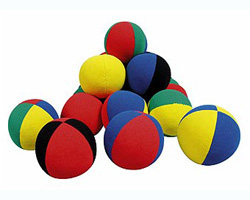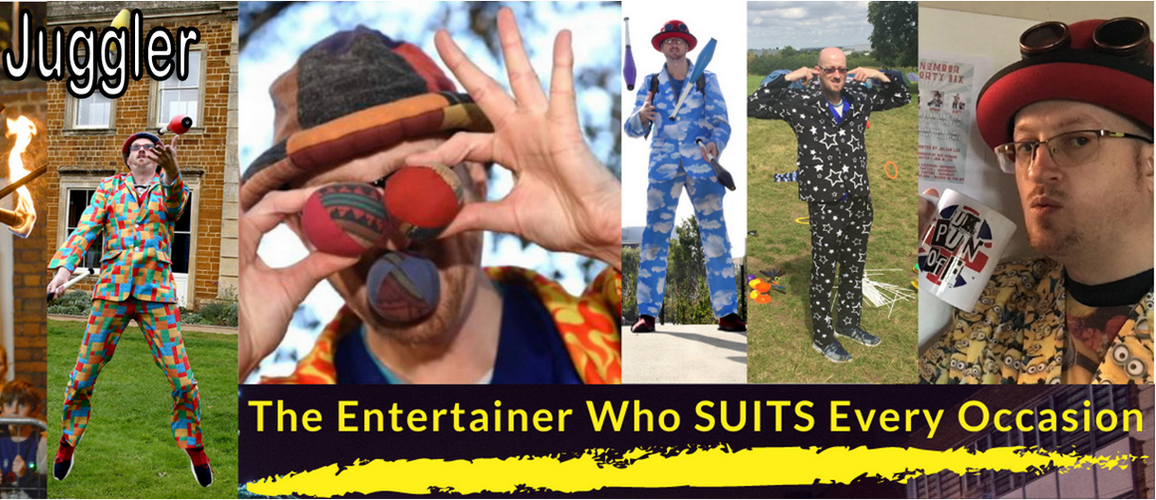 |
Numbers Juggling – A Beginners Guide to the Quest for Juggling More Than 3 Objects at Once! |
Once you have performed some tricks with 3 objects (scarfs, balls, rings or clubs) and you desire to learn how to juggle with 4 objects, you have started on the path of Numbers Juggling!
Numbers Juggling takes a lot of time so you may have to decide whether you prefer learning lots of 3 object tricks or just concentrating on mastering a 4 or 5 object pattern. Non-jugglers do not tend to be entertained by a quick flash or a 7 object pattern as they would be by a series of well orchestrated 3 object tricks, so if your aim is to entertain an audience rather than impressing yourself you may decide that numbers juggling isn’t for you!
Here are links to my 4 Ball Juggling and 5 Ball Juggling pages
Goals of Numbers Juggling:
|
The current world records (as of February 2011) are:
|
Because a flash is less difficult than a qualifying run, you can see that there are numbers “flashed” but not yet “qualified”.
Cascades (odd numbers) & Fountains (even numbers)
Odd: The first pattern that a person juggling odd numbers (3,5,7) of objects learns is a basic crossing pattern called the Cascade.
Even: The first pattern that a person juggling even numbers (4,6,8) of objects learns is called the Fountain. A 6 ball juggler will be juggling 3 balls in each hand simultaneously without any of the balls crossing over to the other hand. Practicing with even numbers of objects involves learning the pattern in one hand until it is solid, then learning with just the other hand until it is solid before putting it all together. When you make a drop, it is usually because one hand has made a bad throw, so you may need to concentrate on just that hand for a while to improve accuracy.
Some people prefer learning with just odd or just even numbers, so it is quite common for a numbers juggler to go from learning the 5 ball cascade straight to learning a 7 ball cascade skipping the 6 ball fountain altogether!
*****************************************
FOLLOW / LIKE / SUBSCRIBE / ENJOY!!
![]()
![]()
![]()
![]()
![]()
![]()
You can hire Steve the Juggler aka Stevie Vegas – for more details try…
Juggler for Hire section – (based in the United Kingdom)
*****************************************
If you are a new Juggler, be sure that you don’t get frustrated with dropping lots of times when you only have 3 objects in the air, as you are going to be doing a whole lot more dropping with an increased amount of objects from now on! It is worthwhile becoming a very good 3 ball juggler and learning lots of tricks before moving on to trying 4 or 5 objects. There is a good reason for this, as you will find that learning the 5 ball cascade is much easier if you practice certain 3 and 4 ball tricks.

Where to Practice
- The more objects you are juggling with = the more height you need as the objects (in order to give you time to think and for them not to collide with each other) require more time and space in the air.
- Most numbers jugglers find themselves looking up at the top of their patterns, so you need to make sure you are not going to be dazzled by the ceiling lights also.
- If you are practicing outdoors, then you are subject to whatever weather (rain and wind, or brightness) is happening!

Which Prop Should I Use?
The most common props that Numbers Jugglers use are Balls, Rings or Clubs. Each have their own advantages and it may simply come down to a choice of which is your favourite prop that you are happiest to learn with. You will see (from the world records above) that Clubs are the hardest to learn with, but Balls and Rings are about the same level of difficulty.

Tips/Advice for Numbers Juggling
- X Catches – If you are getting stuck at a certain number of catches, there could be a whole heap of reasons preventing you from getting to the next catch. If you can find other numbers jugglers and ask for their advice, it will be very helpful to you as they may be able to spot something that you haven’t noticed!
- Rhythm: You need a solid rhythm in order to ensure that the objects are not going to collide. If at any point you were to stop catching the objects and they all hit the ground, would it make a pleasing rhythmic noise or sound very random? Listen to your pattern and try to keep your throw heights the same. Don’t just rush your first few throws to get started. Get a good even tempo right from the very first throw (putting on some music to practice to might help).
- Accuracy: There is less time to correct any errors as you have too many other objects trying to maintain the correct pattern. As soon as one object goes out of sync with all the others, you have a problem which may result in dropping. All that can be said is to be aware of throws that aren’t accurate enough and find ways of improving this skill!

f you have any comments, questions, enquiries or juggling trick suggestions/descriptions, please fill in the form at thef oot of this page or visit the CONTACT STEVE page for many more ways to get in touch (see top menu for the link)! Please note that I am not responsible for any injuries or damage caused by following these trick descriptions. Stay safe!

